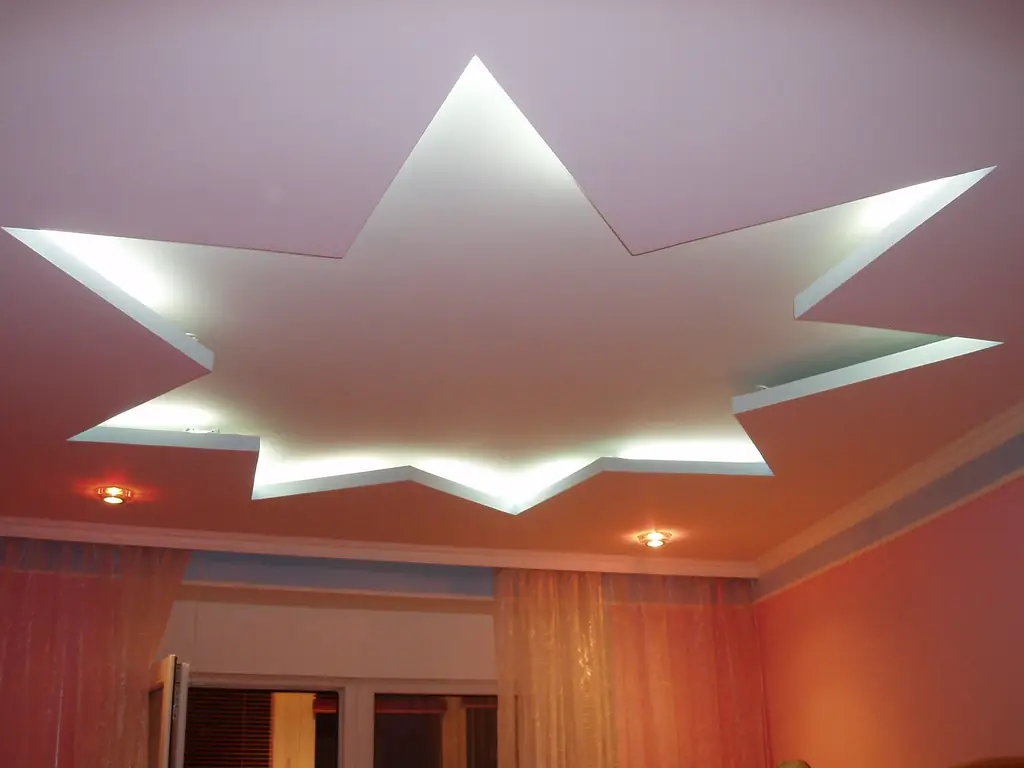
Table of contents:
- Author Bailey Albertson [email protected].
- Public 2023-12-17 12:53.
- Last modified 2025-01-23 12:41.
Drywall ceiling: rules for putty and plaster
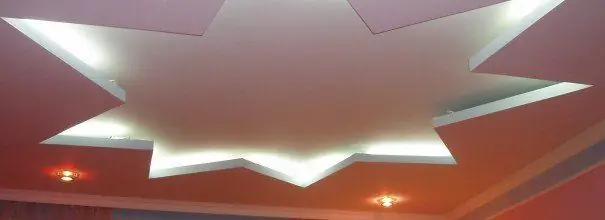
Plasterboard is a convenient facing material for the ceiling. Ceramic tiles are laid on it, wallpaper is glued, stretch ceilings are mounted. You can also apply this type of finish such as putty and plaster. We will consider these finishing options in this article.
Content
- 1 Rules for puttying drywall
-
2 Step by step description of the process
2.1 Details of each stage
- 3 A few tips to help you get the job done right
-
4 Plaster plasterboard ceiling
4.1 Plaster for painting
- 5 Video about plaster and plaster of plasterboard ceiling
Plasterboard rules
First of all, you need to take into account that all joints, seams, dents and holes of fasteners in which the screw heads are located should be putty on the drywall. The starter filler must be prepared just before you apply it. In specialized stores, you can buy dry putty, and then dilute it with water in the proportions indicated on the package.
The solution can be mixed either manually or using a special drill equipped with a mixer. It is important to achieve the consistency of thick sour cream.
Apply the resulting mixture to drywall with a thin layer. A thicker layer of putty will crack after drying. It is most convenient to putty the plasterboard ceiling in several stages: after the first layer of mortar has dried, the next one can be applied.

Remember: a conventional device can burn out due to overload if you use the wrong mixer!
The modern building materials market offers a wide selection of putties, not only in the form of powders, but also pasty. Such a solution is immediately ready for use and can correct any irregularities in the drywall. But sometimes it is easier and cheaper to prepare the putty yourself. It is best to use a drill with a mixer for this.
The mixer must be selected according to the power indicators of the drill used. A conventional device can burn out due to overload if you use any mixer, so it is better to use the smallest one: it will suffice. A special drill for mixing the putty works well with any attachment.
A conventional drill, even at minimum RPM, can run so fast that it sprinkles mortar around you. To avoid this, switch reverse to the counterclockwise position.
Step by step description of the process
In fact, plasterboard ceiling putty differs little from similar work with walls. The biggest problem is that arms, shoulders, back and neck get tired very quickly. Before getting started, arm yourself with the following tools and materials:
- starting putty (consumption of about 3 kg per 1 sq. m.);
- primer (consumption is about 1 kg per 1 sq. m.);
- bandage tape;
- 2 buckets - for clean water and for rinsing tools;
- container for stirring the putty;
- drill with mixing attachment;
- 2 spatulas - 10 cm and 30 cm;
- priming roller;
- rubber gloves.
Do not skimp on the primer, otherwise the putty will dry quickly and subsequently cling to the spatula. If you decide to putty the plasterboard ceiling, which has been serving you for a long time and has become covered with cracks from time to time, you will need to cover the entire surface with a nylon mesh before finishing work.
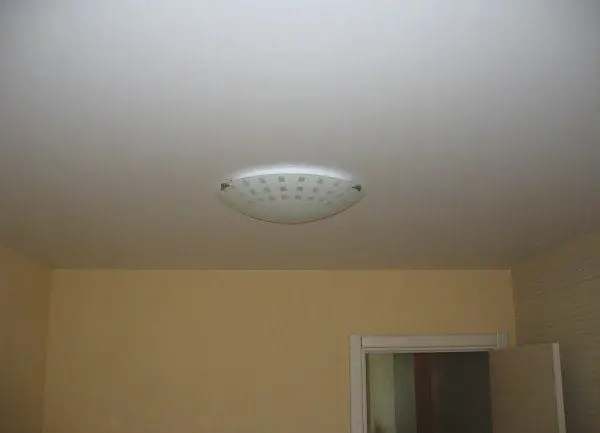
This is how a properly plastered and plastered ceiling looks like
After finishing the work, special styrofoam cornices, fixed around the ceiling perimeter, will help you to give the ceiling a neat look.
Now that we are ready to go, we proceed directly to the process.
Details about each stage
- Prime the ceiling. Pour the required amount of primer from the canister into the prepared container, moisten the roller in it and coat the ceiling. Work with gloves and old clothes that you do not mind: the primer is difficult to clean. If liquid gets on your face, wash your face as often as possible. Also try to scrub the walls and floor in a timely manner if splashed on them.
- The next step is the starting putty. Fill the mortar bucket by a third with water, pour the putty so that it is slightly above the water level, and mix until smooth with a mixer. Pick up the solution with a narrow spatula, transfer it to a wide spatula, and apply it to the ceiling surface with it.
- The starting filler is applied with broad strokes. There is a peculiarity here: if you hold the instrument at an acute angle, then the solution is applied, and if at a blunt angle, then it is removed. The first coat should be even to make the second easier to apply. A smooth surface at this stage is not the main thing, it will be achieved in subsequent stages.
- After the two coats of starting filler are completely dry, remove all unevenness with a wide spatula. Then start finishing the ceiling with a finishing putty, which looks like a finer powder. You need to fill in all the irregularities that appeared when applying the starting layer. If you are preparing the ceiling for painting, the finishing putty must be applied twice.
- When the last layer is dry (this can take from 3 days to a week), you need to start sanding. Work is dusty, so wear special goggles and a respirator. You can purchase a special sander with a dust collector, but this purchase is unlikely to be advisable for a one-time job.
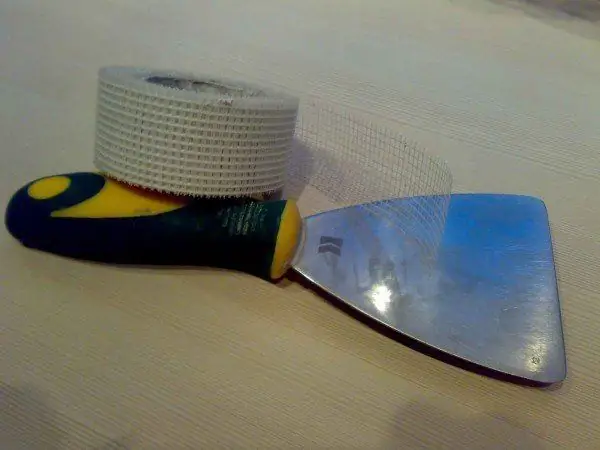
Use bandage tape to reinforce seams
After all this work is completed, your plasterboard ceiling is almost ready for painting. It remains to prime it again, while it is desirable to use a white or transparent primer, otherwise the surface will acquire a yellowish tint and you will have to apply the paint in two layers.
A few tips to help you get the job done right
Pay attention to some of the features that will help you avoid mistakes in the filler work.
- The cut edge of a drywall sheet for a ceiling that is adjacent to a wall is best cut with a knife, removing the edge at an angle of about 45 degrees. When you screw this sheet, keep a distance of a few millimeters from the wall. Under the influence of the putty, the drywall will expand and fix; later this will help to avoid the appearance of cracks.
-
Be sure to fill all cracks with a mortar with a spatula, pressing it firmly to the surface. To ensure accuracy, stretch the short rule regularly.

ceiling putty Hold the trowel at the correct angle to achieve a level surface
- In some cases, "overlaps" of the putty may result. This happens when you start working with a spatula, which has a lot of mortar, and not enough pressure on the tool. This can be avoided by gradually changing the angle of the blade. For example, if at the beginning of the movement the trowel was at an angle of 50 degrees, then you need to finish by moving the slope to 20 degrees.
- Puttying should be done next to the leveled layer, and at the same time move the tool in the direction of the flat area, and not away from it. This way, you can easily smooth out possible sags on the next run; the main thing is that they do not have time to dry out.
- You can remove the build-up as follows: moisten the part of the ceiling that was leveled from the sprayer before starting to putty the next part. When applying the putty, wind the spatula lightly on the leveled wetted surface. If the ceiling has dried out a long time ago, dampen it liberally. This can be done in advance with a roller.
Plaster of plasterboard ceiling
Plastering a plasterboard ceiling is quite simple, since it is even and practically has no flaws, except for the joints between the sheets and the attachment points of the screws. Therefore, as in the case of putty, you need to pay attention to the elimination of these shortcomings.
You can plaster the ceiling in a simple and quick way, which is optimal for the subsequent gluing of wallpapers, especially thick and embossed ones. They will help cover all defects and strengthen the seams.
First, prime the drywall properly. Then fill the grooves and seams with plaster putty. Use a narrow trowel for this and a wide one for leveling. Glue the corners with a serpentine and putty it with the same solution.
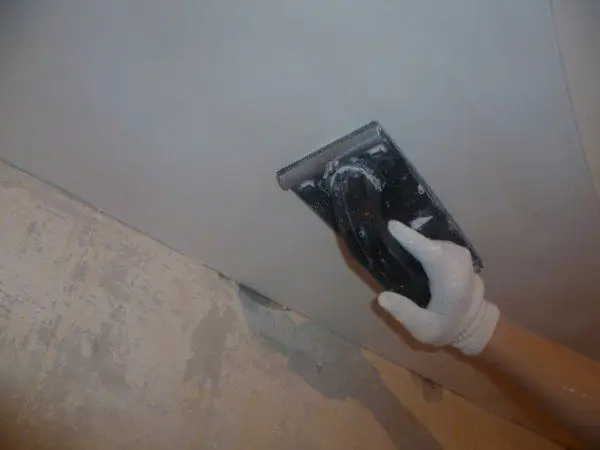
The plaster layer must be dense and perfectly even
After the mortar is dry, rub the seams with a masking net and re-prime the treated surfaces. Now you can glue the wallpaper.
This gives us the following benefits:
- minimum consumption of materials;
- elimination of defects with a minimum investment of time;
- minor remaining imperfections will be hidden under the wallpaper.
Plaster for painting
If you want to plaster the ceiling for painting, you need to use a different method. Acrylic water emulsion will help to hide only small cracks, but not significant irregularities. First and foremost, use the advice given in the previous paragraph to prepare the surface of the plasterboard ceiling.
- After removing all the imperfections, prime the drywall. When doing this, use a brush to prime the seams because the roller will not reach all the grooves.
- Fill the grooves with putty, and place the trowel almost horizontally along the seam. Glue the seams with a serpentine and putty again until the surface is as flat as possible. Fill up the screw holes.
- After the putty is dry, prime the seams again. Then do the banding. Take paper tape and dampen it with water. Apply diluted PVA glue over the seams. Stick the tape and stretch it with a spatula to remove any bubbles and excess glue. Cover the bandage tape with a finishing putty using a wide spatula.
- After that, your plasterboard ceiling is ready to be painted. Liquid wallpaper is perfect for this purpose.
Video about plaster and plaster of plasterboard ceiling
Using our tips, you can easily cope with the processing of a drywall ceiling, even if this job is new to you. If you have any questions on this topic, ask them in the comments, and also share your experience with us. Good luck and easy work!
Recommended:
How And What To Paint A Drywall Ceiling With Your Own Hands + Video
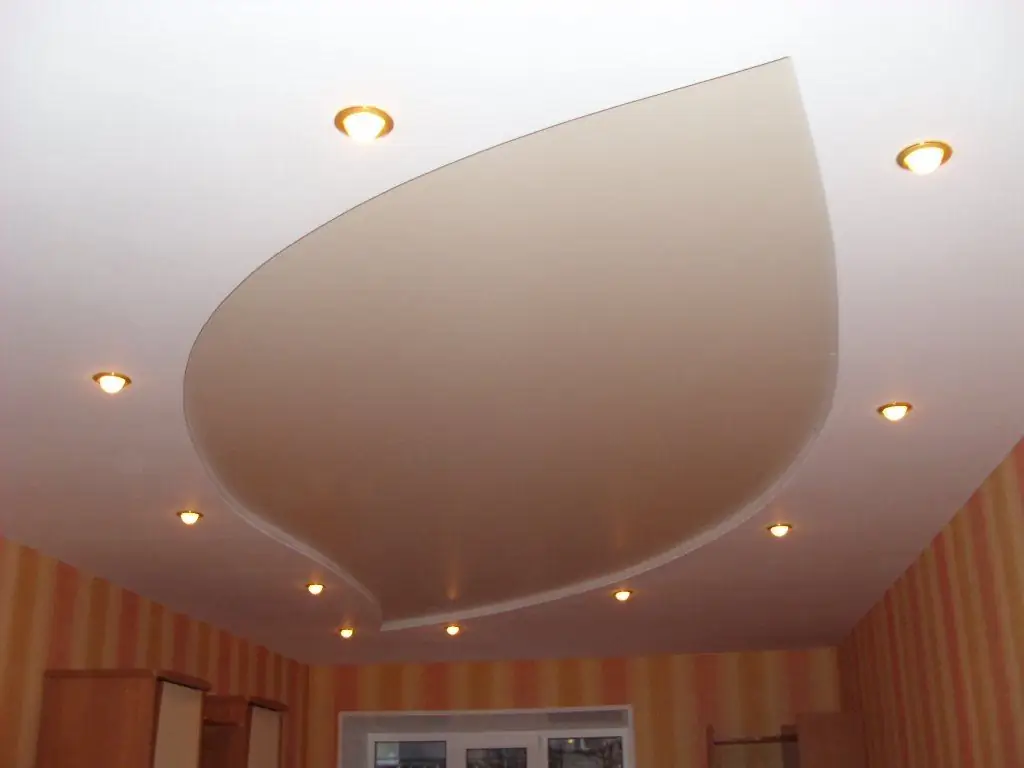
Features of painting a plasterboard ceiling with your own hands. Choosing the right paint. step by step process
How To Wash Off Whitewash From The Ceiling Quickly And Without Dirt + Video

Step-by-step recommendations for flushing old whitewash from the ceiling. Preparing rinsing agents, tips to make the process easier
Installation And Arrangement Of The Roof And Ceiling Of The Bath + Video

Bath roof installation, bath ceiling. Practical installation recommendations, materials used
Figured Ceiling Made Of Plasterboard With Your Own Hands, Wave, Oval And Circle + Photo And Video
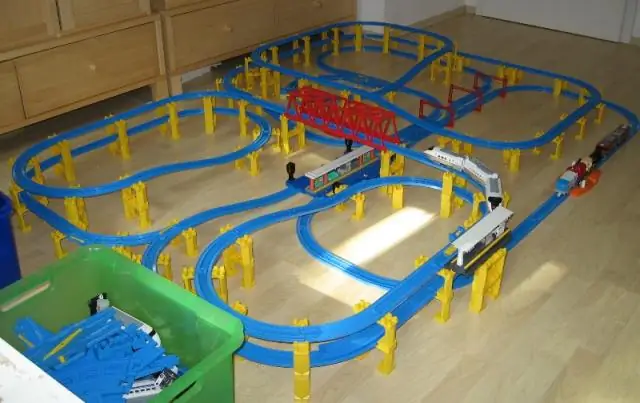
Step-by-step instructions for installing plasterboard ceilings using various curly elements. Materials, tools, tips, design options
Independent Redecoration Of The Ceiling: Whitewashing, Painting, Plastering, Plasterboard Repair + Video

Practical advice and recommendations for DIY ceiling repair. Required materials and tools, step-by-step process description
